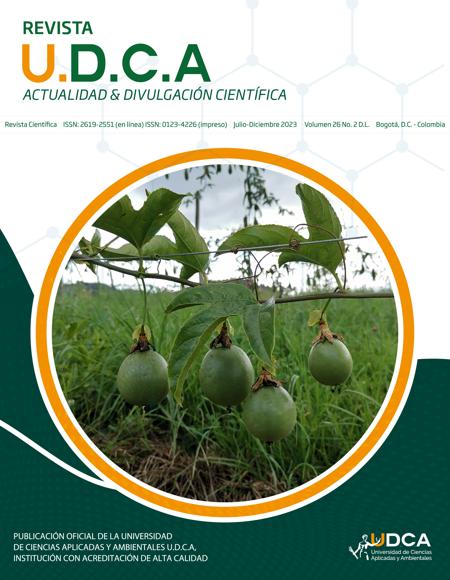Desarrollo de modelo predictivo para el crecimiento de Staphylococcus aureus en queso costeño cubierto con película activa
Development of a predictive model for the growth of Staphylococcus aureus in costeño chesee covered with active film
Contenido principal del artículo
Resumen
Staphylococcus aureus es una bacteria de origen alimentario aislada frecuentemente de quesos responsables de causar intoxicaciones alimentarias. El objetivo de este estudio fue construir un modelo secundario para evaluar el crecimiento de S. aureus en queso costeño, empacado con película activa. Las muestras de queso costeño se inocularon con S. aureus y se cubrieron con la película activa, elaborada con extracto acuoso de Schinopsis balansae. Luego, las muestras de queso se almacenaron a 6, 12, 18 y 21 °C. El modelo de Huang fue ajustado a los datos experimentales de S. aureus, para obtener parámetros de crecimiento. Después, se usó la tasa de crecimiento máxima (µmáx) en función de la temperatura para construir el modelo secundario, usando una ecuación polinomial. La aplicación de película activa de S. balansae tuvo una influencia significativa en los parámetros de crecimiento de S. aureus, como la tasa de crecimiento máxima (μmax), la fase de latencia (λ) y la población celular máxima (Ymax), en el queso costeño. El proceso de validación se realizó midiendo los índices: factor de exactitud (Af), factor de sesgo (Bf) y error cuadrático medio (ECM). El modelo secundario tenía factores Af y Bf cercanos a uno, lo que indica que los modelos obtenidos son viables para predecir el crecimiento de S. aureus en queso envasado con película activa, tomando en consideración la temperatura y el tiempo de almacenamiento.
Palabras clave:
Descargas
Datos de publicación
Perfil evaluadores/as N/D
Declaraciones de autoría
- Sociedad académica
- Universidad de Ciencias Aplicadas UDCA
- Editorial
- Universidad de Ciencias Aplicadas y Ambientales U.D.C.A
Detalles del artículo
Referencias (VER)
AĈAI, P.; VALÍK, L.; MEDVEĎOVÁ, A.; STUDENIČOVÁ A. 2014. Staphylococcus aureus in unripened ewes' lump cheese. Part 1: Exposure assessment after first 24 h of fermentation. Journal Food and Nutrition Research. 53:143-151.
ALJASIR, S.F.; D’AMICO, D.J. 2020. The effect of protective cultures on Staphylococcus aureus growth and enterotoxin production. Food Microbiology. 91:103541. https://doi.org/10.1016/j.fm.2020.103541 DOI: https://doi.org/10.1016/j.fm.2020.103541
BARANYI, J.; PIN, C.; ROSS, T. 1999. Validating and comparing predictive models. International Journal Food Microbiology. 48:159-166. https://doi.org/10.1016/S0168-1605(99)00035-5 DOI: https://doi.org/10.1016/S0168-1605(99)00035-5
BRAUN, P.; SUTHERLAND, J.P. 2003. Predictive modelling of growth and enzyme production and activity by a cocktail of Pseudomonas spp., Shewanella putrefaciens and Acinetobacter sp. International Journal of Food Microbiology. 86:271-282. https://doi.org/10.1016/S0168-1605(02)00564-0 DOI: https://doi.org/10.1016/S0168-1605(02)00564-0
CAI, H.; PEI, S.; ZHANG, Y.; LIU, R.; LU, S.; LI, B.; DONG, J.; WANG, Q.; ZHU, X.; JI, H. 2023. Construction of a dynamic model to predict the growth of Staphylococcus aureus and the formation of enterotoxins during Kazak cheese maturation. Food Microbiology. 112:104234. https://doi.org/10.1016/j.fm.2023.104234 DOI: https://doi.org/10.1016/j.fm.2023.104234
CHOI, W.S.; SON, N.; CHO, J.I.; JOO, I.S.; HAN, J.A.; KWAK, H.S., HONG, J.H.; SUH, S.H. 2019. Predictive model of Staphylococcus aureus growth on egg products. Food Science and Biotechnology. 28:913-922. http://dx.doi.org/10.1007/s10068-018-0529-4 DOI: https://doi.org/10.1007/s10068-018-0529-4
DING, T.; SHIM, Y.H.; KIM, H.N.; HA, S.D.; CHUNG, M.S.; HWANG, I.G.; OH, D.H. 2011. Development of predictive model for the growth of Staphylococcus aureus in Kimbab. Food Science and Biotechnology. 20:471-476. https://doi.org/10.1007/s10068-011-0065-y DOI: https://doi.org/10.1007/s10068-011-0065-y
FOOD AND DRUG ADMINISTRATION, FDA. 2022. Bad bug book: Handbook of foodborne pathogenic microorganisms and natural toxins. Segunda edición. US Food and Drug Administration Silver Spring. Disponible desde Internet en: https://www.fda.gov/food/foodborne-pathogens/bad-bug-book-second-edition
GEITENES, S.; BATISTA DE OLIVEIRA, M.F.; KALSCHNE, D.L.; PEREIRA SARMENTO, C.M. 2013. Modelagem do crescimento de bactérias láticas e análise microbiológica em apresuntado e presunto cozido fatiados e embalados à vácuo. Revista Ciências Exatas e Naturais. 15:113-133.
GOMES DE ARAÚJO, V.; OLIVEIRA ARRUDA, M.D.; DUARTE, F.N.D.; DE SOUSA, J.M.B.; LIMA, M.D.C.; DA CONCEICAO, M.L.; SCHAFFNER, D. W.; LEITE DE SOUZA, E. 2017. Predicting and Modelling the Growth of Potentially Pathogenic Bacteria in Coalho Cheese. Journal of Food Protection. 80(7):1172-1181. https://doi.org/10.4315/0362-028X.JFP-16-523 DOI: https://doi.org/10.4315/0362-028X.JFP-16-523
GONZÁLEZ-CUELLO, R.; GUARDO-PALOMINO, F.; SÁNCHEZ-CASTILLA, A.; ALVEAR-PICÓN, M.; MARSIGLIA-FUENTES, R. 2018. Changes of the dynamic properties of films based on carrageenan by microcapsules incorporation. Contemporary Engineering Sciences. 11:689-696. https://doi.org/10.12988/ces.2018.8266 DOI: https://doi.org/10.12988/ces.2018.8266
HUANG, L.H. 2013. IPMP 2013 A comprehensive data analysis tool of predictive microbiology. International Journal of Food Microbiology. 171:100-107. https://doi.org/10.1016/j.ijfoodmicro.2013.11.019 DOI: https://doi.org/10.1016/j.ijfoodmicro.2013.11.019
KIM, Y.H.; NAM, G.W.; YOON, K.S. 2018. Growth and survival of Staphylococcus aureus on beef jerky as a function of temperature. Journal of Food Safety. 38:12495. https://doi.org/10.1111/jfs.12495 DOI: https://doi.org/10.1111/jfs.12495
LIN, L.; YUN, H.; WU, Y.; CHEN, M.; OU, J.; YAN, L. 2018. Assessment of the inhibitory effects of sodium nitrite, nisin, potassium sorbate, and sodium lactate on Staphylococcus aureus growth and staphylococcal enterotoxin A production in cooked pork sausage using a predictive growth model. Food Science and Human Wellness. 7:83-90. https://doi.org/10.1016/j.fshw.2017.12.003 DOI: https://doi.org/10.1016/j.fshw.2017.12.003
LÓPEZ, F.N.; QUINTANA, M.C.; FERNÁNDEZ, A.G. 2006. The use of a D-optimal design to model the effects of temperature, NaCl, type and acid concentration on Lactobacillus pentosus IGLAC01. Journal of Applied Microbiologgy. 101:913-926. https://doi.org/10.1111/j.1365-2672.2006.02979.x DOI: https://doi.org/10.1111/j.1365-2672.2006.02979.x
LOTHA, R.; SHAMPRASAD, B.; SUNDARAMOORTHY, N.; GANAPATHY, R.; NAGARAJAN, S.; SIVASUBRAMANIAN, A. 2018. Zero valent silver nanoparticles capped with capsaicinoids containing Capsicum annuum extract, exert potent anti-biofilm effect on food borne pathogen Staphylococcus aureus and curtail planktonic growth on a zebrafish infection model. Microbial Pathogenesis. 124:291-300. https://doi.org/10.1016/j.micpath.2018.08.053 DOI: https://doi.org/10.1016/j.micpath.2018.08.053
PASCH, H.; PIZZI, A.; RODE, K. 2001. MALDI-TOF mass spectrometry of polyflavonoid tannins. Polymer. 42:7531-7539. https://doi.org/10.1016/S0032-3861(01)00216-6 DOI: https://doi.org/10.1016/S0032-3861(01)00216-6
PÉREZ, F.; VALERO, A. 2013. Predictive microbiology in foods. Ed. Springer New York, NY. p.128
ROSS, T. 1999. Predictive food microbiology models in the meat industry. Meat and livestock Australia Sydney, Australia. p.196.
RUBAB, M.; SHAHBAZ, H.M.; OLAIMAT, A.N.; OH, D.H. 2018. Biosensors for rapid and sensitive detection of Staphylococcus aureus in food. Biosnsors and Bioelectronics. 105:49-57. https://doi.org/10.1016/j.bios.2018.01.023 DOI: https://doi.org/10.1016/j.bios.2018.01.023
SALVAT, A.; ANTONACCI, L.; FORTUNATO, H.; SUAREZ, Y.; GODOY, M. 2001. Screening of some plants from Northern Argentina for their antimicrobial activity. Letters in Applied Microbiology. 32:293-297. https://doi.org/10.1046/j.1472-765x.2001.00923.x DOI: https://doi.org/10.1046/j.1472-765X.2001.00923.x
SARAIVA, A.M.; SARAIVA, C.L.; CORDEIRO, R.P.; SOARES, R.R.; XAVIER, H.S.; CAETANO, N. 2013. Atividade antimicrobiana e sinérgica das frações das folhas de Schinopsis brasiliensis Engl. frente a clones multirresistentes de Staphylococcus aureus. Revista Brasileira de Plantas Medicinais. 15:199-207. https://doi.org/10.1590/S1516-05722013000200006 DOI: https://doi.org/10.1590/S1516-05722013000200006
VALÍK, L.; AČAI, P.; MEDVED’OVÁ, A. 2018. Application of competitive models in predicting the simultaneous growth of Staphylococcus aureus and lactic acid bacteria in milk. Food Control. 87:145-152. https://doi.org/10.1016/j.foodcont.2017.12.018 DOI: https://doi.org/10.1016/j.foodcont.2017.12.018
VENTER, P.B.; SISA, M.; VAN DER MERWE, M.J.; BONNET, S.L.; VAN DER WESTHUIZEN, J.H. 2012. Analysis of commercial proanthocyanidins. Part 1: The chemical composition of quebracho (Schinopsis lorentzii and Schinopsis balansae) heartwood extract. Phytochemistry. 73:95-105. https://doi.org/10.1016/j.phytochem.2011.10.006 DOI: https://doi.org/10.1016/j.phytochem.2011.10.006
VILLANUEVA, D.; MARRUGO, J. 2014. Efectos de los ácidos grasos de la dieta y sus metabolitos en células de la respuesta alérgica. Revista Médica Sanitas. 17:212-230.
YU, H.H.; SONG, Y.J.; KIM, Y.M.; LEE, H.Y.; CHOI, Y.S.; LEE, N.K.; PAIK, H.D. 2020. Predictive model of growth kinetics for Staphylococcus aureus in raw beef under various packaging systems. Meat Science. 165:108108. https://doi.org/10.1016/j.meatsci.2020.108108 DOI: https://doi.org/10.1016/j.meatsci.2020.108108







